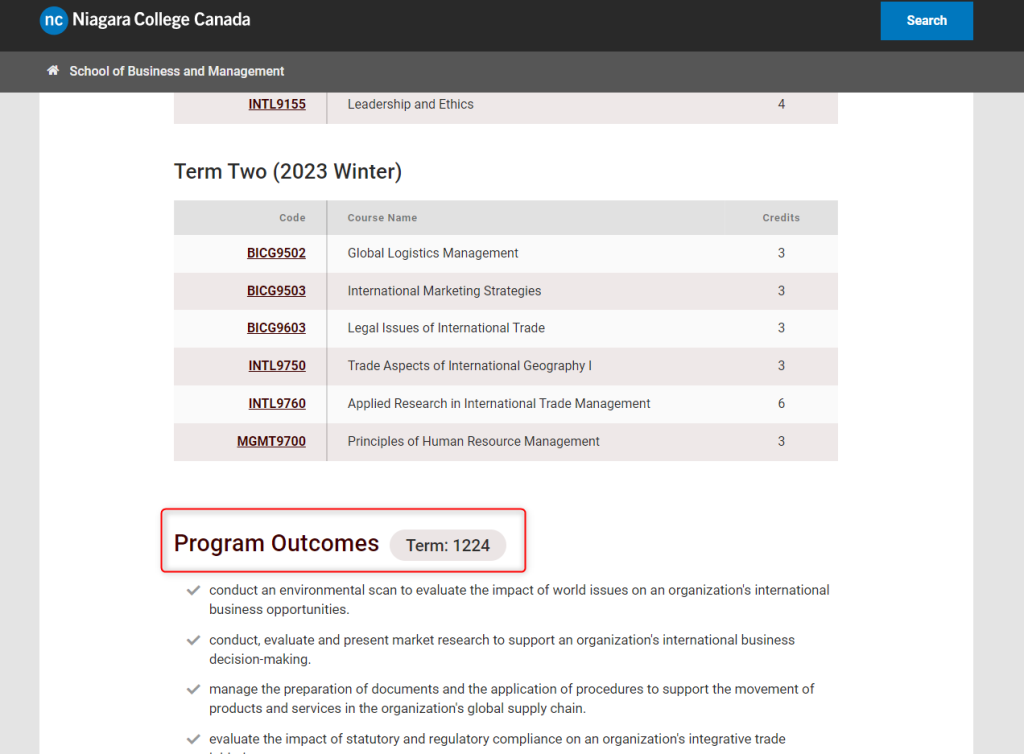Program Standards and Vocational Outcomes
It’s All About Outcomes
The most crucial information in the course outline that guides the design, development, and delivery of a course are the learning goals or directives: the Program or Vocational Learning Outcomes, the Course Learning Outcomes, and Course Objectives.
Programs are composed of constructively aligned courses that contribute toward the achievement of program-level learning outcomes. The program-level learning outcomes are designed to reflect the context of institutional-level graduate attributes, and provincial or disciplinary accreditation expectations.
In a constructively aligned program, the courses are carefully coordinated to ensure steady development or scaffolding from introduction to mastery (i.e., proficiency in the demonstration) of the learning outcomes, leading to achievement of the intended program-level outcomes.
 In a constructively aligned course, the course learning objectives, learning experiences, and assessment tasks work together to mutually reinforce the achievement of the course-level learning outcomes. By their nature as descriptions of success, learning outcomes are tied to assessment, which is most effective if it takes place in the context of a discipline, profession, program and/or course.
In a constructively aligned course, the course learning objectives, learning experiences, and assessment tasks work together to mutually reinforce the achievement of the course-level learning outcomes. By their nature as descriptions of success, learning outcomes are tied to assessment, which is most effective if it takes place in the context of a discipline, profession, program and/or course.
Outcomes-based learning in the framework of constructive alignment (Biggs & Tang, 2007) helps course developers observe, measure, and assess learning outcomes. Once the learning outcomes and assessment tasks are determined, the learning activities, teaching methods and resources required to achieve those outcomes and assessments may be planned. In turn, every element of a course supports the intended learning.
According to Biggs and Tang (2007), all aspects of teaching and learning in a course should be aligned to the appropriate program-level learning outcome to ensure clarity of focus in the assessment activities (see figure 1 below). Course or unit learning objectives inform the design and organization of teaching strategies, learning activities, assessments, and resources to help students achieve the learning outcomes at the course level.
 Figure 1: Constructive Alignment. [Image Description].
Figure 1: Constructive Alignment. [Image Description].
Program Learning Outcomes
Depending on the program, your course outline will identify the specific sub-set or mix of learning outcomes and objectives intended to contribute to the overarching training, employability, and citizenship goals for learners enrolled in the program.
Where do I find the Program Learning Outcomes?
Program Standards and Vocational Learning Outcomes (VLOs)
The Ministry of Colleges and Universities (MCU) oversees the development and the review of standards for Programs of Instruction (POI) to clearly identify the essentials skills and knowledge that graduates of each program must acquire. The MCU standards are based on achievement of Vocational, Essential Employability Skills, and General Education goals.
Watch the video below for a short overview of Ministry of Colleges and Universities’ program standards.
For new program fields, the college can develop programs that respond to local and emerging industry trends and set the learning outcomes. These institution specific programs are classified within the college setting as ‘description’ programs. As such, description programs may not adhere to the MCU vocational learning standards.
What’s the difference?
Both description and standard programs have vocational learning outcomes. For standard programs, the VLOs are set by the MCU. They are constructed word-for- word and must not be changed. For descriptor programs, the college sets the program learning outcomes which can be modified through internal college processes.
Know Your VLOs
If you are developing a course, ensure you know the program standards for this course before proceeding. All program standards — apart from programs that fall into a description category — are posted on the MCU website.
Image Descriptions
References
Biggs, J., & Tang, C. (2007). Using Constructive Alignment in Outcomes-Based Teaching and Learning Teaching for Quality Learning at University (3rd ed., pp. 50-63). Maidenhead: Open University Press.
An outcomes-based approach to course design that involves identifying learning outcomes, designing evaluation methods, and teaching and learning activities that measure and support students’ achievement of those outcomes.
A person tasked with developing it redeveloping a course; designs the curriculum, content, and activities for educational courses.


